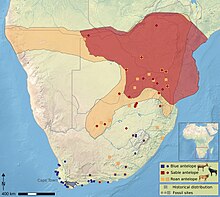Our website is made possible by displaying online advertisements to our visitors.
Please consider supporting us by disabling your ad blocker.
Bluebuck
| Bluebuck Temporal range:
| |
|---|---|

| |
| One of four existing bluebuck skins, Vienna Museum of Natural History. The overall blue colouration is caused by the lighting. | |
| Scientific classification | |
| Domain: | Eukaryota |
| Kingdom: | Animalia |
| Phylum: | Chordata |
| Class: | Mammalia |
| Order: | Artiodactyla |
| Family: | Bovidae |
| Subfamily: | Hippotraginae |
| Genus: | Hippotragus |
| Species: | †H. leucophaeus
|
| Binomial name | |
| †Hippotragus leucophaeus (Pallas, 1766)
| |

| |
| Historical distribution and Holocene and Pleistocene fossil sites of bluebuck (blue), sable antelope (red), and roan antelope (yellow) in southern Africa | |
| Synonyms[2][3] | |
|
List
| |
The bluebuck (Afrikaans: bloubok /ˈblaʊbɒk/) or blue antelope (Hippotragus leucophaeus) is an extinct species of antelope that lived in South Africa until around 1800. It was smaller than the other two species in its genus Hippotragus, the roan antelope and sable antelope. The bluebuck was sometimes considered a subspecies of the roan antelope, but a genetic study has confirmed it as a distinct species.
The largest mounted bluebuck specimen is 119 centimetres (47 in) tall at the withers. Its horns measure 56.5 centimetres (22.2 in) along the curve. The coat was a uniform bluish-grey, with a pale whitish belly. The forehead was brown, darker than the face. Its mane was not as developed as in the roan and sable antelopes; its ears were shorter and blunter, not tipped with black; and it had a darker tail tuft and smaller teeth. It also lacked the contrasting black and white patterns seen on the heads of its relatives. The bluebuck was a grazer, and may have calved where rainfall, and thus the availability of grasses, would peak. The bluebuck was confined to the southwestern Cape when encountered by Europeans, but fossil evidence and rock paintings show that it originally had a larger distribution.
During the Late Pleistocene, the bluebuck was common across South Africa, but by the time Europeans encountered the bluebuck in the 17th century, it was already uncommon, perhaps due to its preferred grassland habitat having been reduced to a 4,300-square-kilometre (1,700 sq mi) range, mainly along the southern coast of South Africa. Sea level changes during the early Holocene may also have contributed to its decline by disrupting the population, and it appears that it may have adapted for a low effective population size. The first published mention of the bluebuck is from 1681, and few descriptions of the animal were written while it existed. The few 18th-century illustrations appear to have been based on stuffed specimens. Hunted by European settlers, the bluebuck became extinct around 1800; it was the first historically recorded species of large African mammal to face extinction. Only four mounted skins remain, in museums in Leiden, Stockholm, Vienna, and Paris, along with horns and possible bones in various museums.
- ^ Kerley, G.; Child, M.F. (2017). "Hippotragus leucophaeus". IUCN Red List of Threatened Species. 2017: e.T10168A50188573. doi:10.2305/IUCN.UK.2017-2.RLTS.T10168A50188573.en. Retrieved 19 November 2021.
- ^ Grubb 2005, p. 718.
- ^ Sclater & Thomas 1899, pp. 4–12.
Previous Page Next Page



